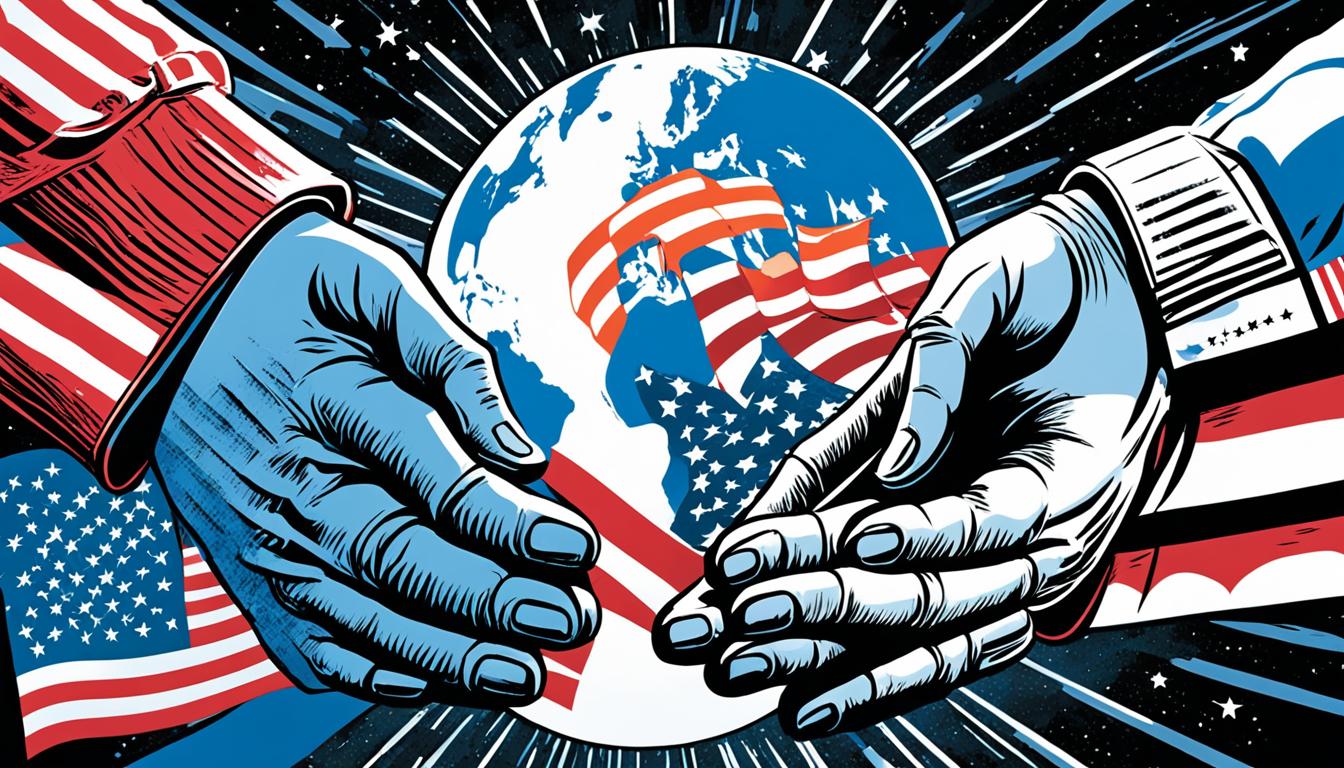Russia has been a key player in space collaboration, impacting the world of aerospace, international ties, and technology. Let’s look at the various roles Russia has played in this field.
Think about a space station in orbit with astronauts from many nations working together. They do important research and explore new frontages. This places is the International Space Station (ISS), a beacon of joint effort and scientific progress1.
In the ISS program, Russia is a leading partner. It helps keep this incredible project running. Its teamwork with space agencies from the USA, Europe, Japan, and Canada breaks down global barriers1.
The ISS is not just for research but also shows how well countries can work together. Astronauts from 18 countries have visited it, showing how many nations are involved in this project1.
Russia’s role in the ISS and other partnerships has greatly affected aerospace technology. For example, a 2019 China-Russia deal gave China access to special missile defense tech. This deal shows how global space competition is changing and its effects on world relations2.
Also, Russia and China have teamed up on satellite and moon missions. In 2014, they agreed to work on satellite navigation, helping each other improve systems. And in 2021, they planned together for a moon research base2.
This closer Russia-China space bond signals a new phase, with China becoming more prominent. Such teamwork could challenge U.S. defenses against missiles, increasing the chance of global conflicts2.(`p`>
Looking deeper into Russia’s space collaboration, we’ll see its effects on aerospace industries, nonproliferation, U.S.-Russia relations, and international politics. It’s a complex mix of competition and teamwork in space21.
Key Takeaways:
- Russia’s space collaborations, especially through the ISS, greatly influence global aerospace and international politics1.
- The ISS combines flights, launch sites, operations, training, and science from all over the globe1.
- A total of 18 countries have sent astronauts to the ISS, showing widespread global involvement1.
- Space collaboration between Russia and China is evolving, with China leading, thanks to Russian support2.
- This teamwork could make it harder for the U.S. to control missile threats, potentially heightening global tensions2.
The Rationales for Expanded Space Cooperation
Russia and other countries, like the United States, are joining forces in space for many reasons. These include improving space tech, saving money, and enhancing foreign relations and security.
One main reason for this teamwork is to use Russia’s space knowledge to boost the U.S. space program. The U.S. benefits from Russia’s tech and infrastructure, which can lead to big achievements in space exploration. This partnership helps share ideas and solutions, cutting costs by doing missions together and using the same facilities3.
In 1993, Russia was asked to join the team building the international space station. This move, involving the U.S., Japan, Canada, and European countries, built a strong base for space teamwork. It helped improve relationships between countries and encouraged global cooperation in space3.
Security is another big reason behind this cooperation. Countries work together to keep space safe by sharing info and research. This teamwork protects space assets and promotes peace and stability up there3.
Money matters also drive countries to join forces in space. By sharing the costs and working together on research, they get more value for their money. This helps grow the economy by creating new tech, business deals, and industries related to space3.
There are many reasons why countries are working together more in space. They want to improve their space programs, save money, support foreign policy, boost security, and grow the economy. By combining their strengths, they can explore space further, learn more, and use outer space better for humanity’s progress.
Impacts on Russian Aerospace Industrial Base
Russia’s aerospace base has grown thanks to its work with other countries in space. These teams have shared technology and pushed aerospace skills higher. They have also helped in keeping space peaceful.
Russia and its partners, like China, have put a lot of money into space. In 2023, China spent $14.15 billion on its space projects, up 19% from the year before. Russia spent $3.41 billion, a bit less than in 20224. This shows both countries’ strong interest in discovering more about space.
Russia’s work with China and others has led to the sharing of advanced technology. This sharing means Russian aerospace can make new, top-notch technology. For example, Russia and China’s plan to build a nuclear power plant on the Moon by 20354. It shows how these countries work together to reach new heights in space.
Such cooperation in space has helped keep space peaceful. By working together, countries like Russia help make sure space is used in a good way. At places like the UN Security Council5, they talk about keeping space for peace and science.
But, Russia’s aerospace base does face problems. For instance, its satellite navigation system is getting old5. Many satellites are not working well because they’re outdated. This points to a need for more investment in space tech.
To end, working together in space has greatly helped Russia’s aerospace. It has allowed for sharing technology, improving skills, and promoting peace in space4. Despite some issues, Russia’s role in space shows its dedication to bettering aerospace and joining global space efforts.
Impacts on Nonproliferation and Technology Transfer
Space cooperation between Russia and other countries has made a big difference in stopping the spread of nuclear weapons and sharing technology6. By working together, they have spread knowledge and technology. This helps the world work towards preventing the spread of nuclear arms and improving technology.
The Nuclear Non-Proliferation Treaty was established in 1968 by nuclear and non-nuclear states. Its goal was to stop nuclear tech from spreading6. It aimed to keep nuclear weapons and technology from being passed around. The International Atomic Energy Agency (IAEA) checks to make sure nuclear tech doesn’t get spread wrongly6.
However, countries like France and China, along with others, didn’t join the NPT. This affected how well the treaty worked6.
Space collaboration has also boosted the sharing of technologies between nations. This exchange has improved areas such as aerospace technology. It strengthens global efforts to stop nuclear tech from being misused, by helping countries use nuclear tech safely and peacefully6.
International agreements like the 123 Agreement support nuclear cooperation for peaceful purposes7. The NPT, which started in 1970, remains vital for stopping the spread of nuclear weapons7.
Programs like the G-8 Global Partnership and UN Security Council Resolution 1540 focus on stopping weapons of mass destruction from spreading. They also help countries follow non-proliferation rules7. Conventions like the CPPNM and the International Convention on Nuclear Terrorism ensure nuclear materials are safe and fight against nuclear terrorism7.
The Nonproliferation Review is a key resource for those making policies and for scholars8. It publishes articles on international treaties like the NPT, focusing on important issues related to nuclear security and weapons spread8.
It also encourages discussions and research through book reviews related to stopping nuclear arms spread8. The Doreen and Jim McElvany Nonproliferation Prize rewards authors of standout submissions, highlighting the value of research in this area8.
In summary, space cooperation plays a crucial role in stopping nuclear weapons spread and in sharing technology. Through collaborations and efforts, countries share their knowledge and technologies. This aids in achieving global goals to prevent nuclear proliferation and enhances developments in many areas.
Impacts on Overall U.S.-Russian Relations
Space collaboration has brought the United States and Russia closer, creating a path for international teamwork. Working together in space has helped these two countries build strong relations. It has strengthened their ties, showing how teamwork can lead to positive outcomes.
The International Space Station (ISS) is a great example of U.S.-Russian cooperation. Right now, seven people live on the ISS. This crew includes four Americans, two Russians, and one German9. Their work together highlights the level of trust and international cooperation in space exploration.
Russia plays a vital role in keeping the ISS in orbit9. This shared duty shows the deep trust and reliance between the United States and Russia. It proves that their space collaboration goes beyond political issues, underlining its importance.
There have been hurdles, like Russia’s uncertainty about continuing the collaboration beyond 2024. The U.S., however, plans to support the ISS until 20309. Despite these challenges, joint ventures, such as commercial partnerships, help bridge gaps. Working with companies like SpaceX has lessened the U.S.’s dependence on Russia for space trips. This shows how flexible and strong their space relationship is9.
Political tensions and sanctions on Russia can affect space cooperation. For example, the European Space Agency’s Mars mission, needing a Russian rocket, faced doubts due to political issues9. Also, a planned Russian launch for the British company OneWeb got canceled. These situations show how politics can influence space collaboration9.
In conclusion, space collaboration between the U.S. and Russia has deeply influenced their relationship. Their shared space missions have fostered international diplomacy, showing how countries can work together above political differences. Yet, geopolitical tensions can challenge this teamwork. It’s essential to keep striving to maintain and enhance the U.S.-Russian bond in space.
The New Space Race and Global Geopolitics
The new space race is big in world politics and the way countries interact. Nations are pushing hard into space, making it a part of global politics. This shows how science, technology, and political power are all connected.
Countries like the US, China, and Russia are all in this space race. They all want to achieve their own goals. This competition is not just about exploring space. It also affects who has power in the world and how countries work together.
A big reason for the race is to achieve new tech and scientific discoveries. Over 80 countries are now in space, showing a big jump in global interest10. In the US, private businesses are spending more on space research. This shows that companies also play a big role in space exploration10.
Space mining is also getting attention, especially with China’s large metal reserves10. Mining in space could help countries depend less on Chinese resources.
The Moon could help meet the world’s energy needs with its helium-310. This could be a game-changer for how we get energy in the future.
Satellites are more important than ever for daily life and keeping countries safe. The UK could lose a lot of money if its satellites were ever disrupted10. This shows how crucial space technology is to our world.
While countries compete in space, working together has always helped humanity. The International Space Station is a great example of what can be achieved together10. Working together in space can help us all understand more, make new scientific discoveries, and promote peace.
The space race is changing how countries relate to each other and the balance of power. As nations try to be the best in space, working together becomes even more important. This competition is where science, tech, and politics meet. It will shape our future on Earth and in space.
| Key Points | Statistical Data Reference |
|---|---|
| Over 80 countries currently have a presence in space | 10 |
| Private companies in the USA have significantly increased their spending on research and development | 10 |
| China holds a third of theoutgoing links world’s known reserves of certain metals | 10 |
| The Moon is believed to contain vast reserves of helium-3 | 10 |
| The UK stands to lose an estimated £1 billion per day if satellites are disrupted | 10 |
| Collaboration in space exploration has historically led to breakthroughs benefiting humanity | 10 |
Tensions and Collaboration in Space
Space activities come with tension and cooperation as countries want to be leading and grow in science. But, lacking global rules often causes conflicts and competition. Yet, working together is key for space exploration and discovering new science.
The International Space Station (ISS) shows how well collaboration works in space. Right now, there are four US astronauts, three Chinese astronauts, and three Russian cosmonauts on the ISS. This diverse group11helps share knowledge and understanding across nations.
In 2022, Russia talked about leaving the ISS by 2024, later pushed to 202811. This move worries many about future teamwork and the science gained from working together.
The Role of Collaboration in Mitigating Tensions
Working together in space is not just for science but also helps reduce tension between countries. It’s very important to have clear, agreed-upon rules to prevent conflicts and keep peace.
Private space firms like SpaceX, led by Elon Musk and worth $125 to $140 billion, could help keep the ISS going if Russia leaves11. SpaceX might support the station with tools or money. It shows how important different partners and the private sector are for the future of space travel.
Evolution of Strategic Partnerships
The space industry’s changing nature leads to new partnerships. The European Space Agency (ESA) is thinking about using its own launchers instead of Russia’s “Soyuz” capsules11. This possibility marks a change in partnerships and strategies in space.
China is becoming a big player in space, challenging the usual leaders like the USA and Russia11. With its successful Moon missions and its own space station, China’s growth advocates for more global cooperation. This will help keep space exploration peaceful and fruitful.
Conclusion
Since 1957, Russia’s work with other countries in space has changed the world. The USSR launched the first satellite, leading to big achievements like the first person in space and the first Mars mission1213. These steps have pushed the boundaries of space technology and started a global competition to explore space.
Even with political tensions, working together in space is key for new discoveries and peaceful exploration. The United States and Russia, for example, teamed up for the Apollo-Soyuz mission in 1975. This mission marked the end of the space race in a symbolic way12. Nowadays, making rules and working internationally are crucial for the future in space.
Russia’s ongoing participation in space is important for the world’s approach to space. As China and Russia grow their space skills, working together becomes more critical. The U.S. Space Force sees the value in partnering with private companies. This helps make the most of new technologies and strengthens space security14. Combining commercial space technologies can lower costs, create jobs, and help many industries14. Also, the USSF’s work with allies, schools, and businesses shows a strong commitment to solving space problems14.
In the end, Russia’s work in space has deeply influenced aerospace, international relations, and technology worldwide. As countries keep pushing into space and growing their skills, working together will be essential. It ensures the ongoing growth of science and peaceful space exploration.










